Guides • Understanding Publishing
Last updated on Sep 01, 2023
Parts of a Book: Front Matter, Back Matter and More
About the author
Reedsy's editorial team is a diverse group of industry experts devoted to helping authors write and publish beautiful books.
More about the Reedsy Editorial Team →Linnea Gradin
The editor-in-chief of the Reedsy Freelancer blog, Linnea is a writer and marketer with a degree from the University of Cambridge. Her focus is to provide aspiring editors and book designers with the resources to further their careers.
View profile →Most printed and published books can be divided into three sections: the front matter (like the cover, copyright page, and table of contents), the main body of the book, and the back matter (like acknowledgements and indexes). Together, they help organize information for the reader.
In the table below, you can see a more detailed breakdown of what goes into each part of a book:
| Front matter | Body | Back matter |
|
Accolades |
Prologue |
Acknowledgements |
☝️ Note that no book will include all of these parts at once, and you may occasionally find things like the copyright page in the back matter rather than the front matter too.
In this guide, we’ll dissect the different parts of a book, covering which components can (and should) be included in the final product. In subsequent sections, we'll burrow deeper into the most common and important sections of a book's front, body, and back matter. But first, let's start with a wide-angle view, beginning with...
The front matter of a book
The front matter of a book is everything between the front cover and the very first pages of the main text: the title page, copyright page, table of contents, etc. These pages are usually not written by the author themselves, but rather by someone familiar with their work or the publisher, and the pages are usually not numbered.
Though many readers skip right over it, the front matter contains some pretty important information about the book's author and publisher, not to mention fine print legal text. And for those who do read it, the front matter can form their first impression, so it’s important to get it right!
🤓 Literary theorist and scholar Gérard Genette suggested that all the additional pieces of information that sandwich a story, such as author name, preface, and illustrations, actually have an effect on how we interpret the main text. He referred to this as “paratext.”
📱Ebooks can sometimes be formatted slightly differently, but generally follow the same patterns as print books with a title page, copyright page, preface, and so on. However, many ebooks will have a clickable table of contents that helps you navigate to the right chapter, even if the print book does not contain a table of contents.
Now, let’s take a closer look at what you may find in the front matter, in the order you will usually find it:
Accolades
Many publishers will put any praise and rave reviews from reputable sources on the cover, and those that didn’t fit on a separate page in the front matter of the book. The placement means that it’s one of the first things readers will see if they flip through the pages in a bookstore, which could help further persuade anyone who is still on the fence.
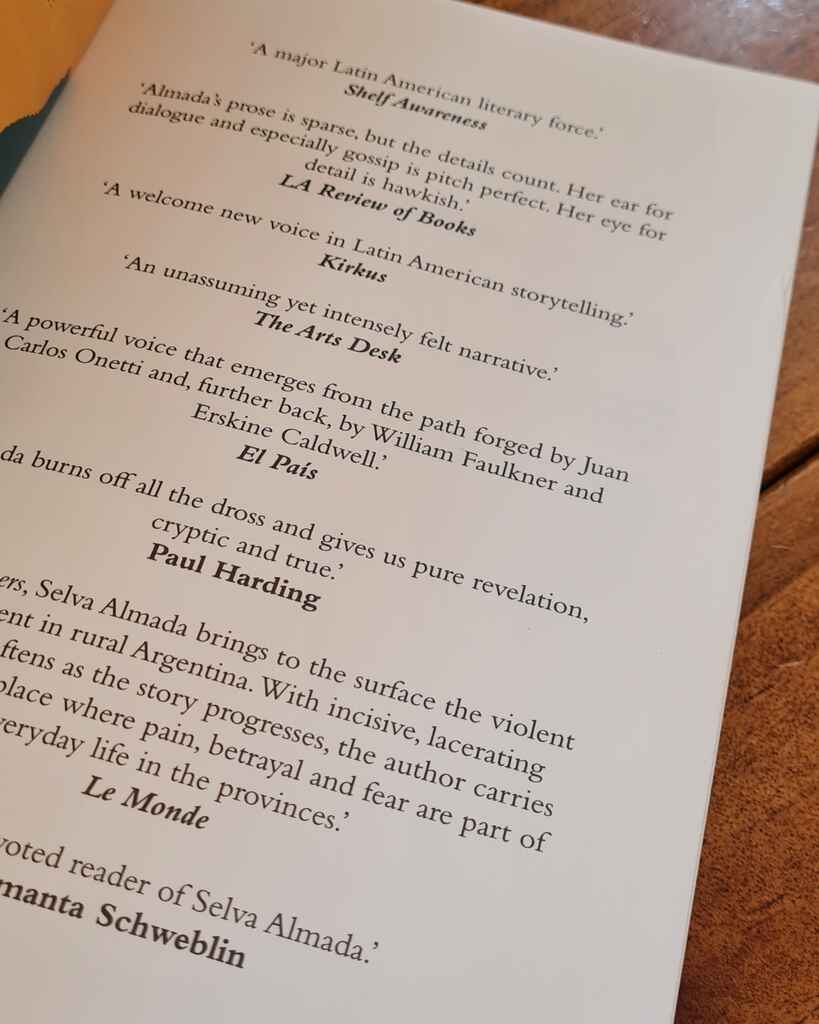
Praise for Selva Almada 's Brickmakers.
Check out Ricardo Fayet’s free guide "How to Market a Book" to learn about the power of a good review.
Half-title
Also known as the bastard title page, the half-title page is a blank page with nothing but the title of the book, written in a plain font without frills or decorations.

Half-title or bastard title page of Selva Almada’s Brickmakers.
Traditionally, when readers bought books without covers and added their own, custom-made leather covers, the purpose of the half-title was to protect the more ornamental title page and frontispiece (more on this later) during the bookbinding process. Now, it’s the perfect place to ask for an author signature.
Copyright page
Also called a “colophon,” the copyright page includes technical information about copyrights, edition dates, typefaces, ISBN, as well as your publisher and printer info. It usually appears on the reverse of the title page, if not already taken by the frontispiece, and occasionally in the back matter of the book.
☝️ If you’re not sure what information needs to go on your copyright page or how to set it up, you can simply input the information into Reedsy Studio — our free online writing tool — and it will automatically generate your copyright page for you, along with any other parts you want to go in the front matter, body, or back matter of your book.
Meet the top book interior designers on Reedsy
Daniel P.
Available to hire
I love books, and I want to help with yours! After 15+ years and 100s of projects, I know what it takes to make your book look its best!
Rachel S.
Available to hire
Fine artist turned illustrator. Using a blend of paint + graphics to design books. Confession: I buy books by their covers!
Erica P.
Available to hire
Graphic designer with over five years of publishing experience, primarily with layout design for hardcover coffee-table books.
Title page
The title page features the full title of the book and the author's name — as they appear on the cover — and any potential subtitle, translator, as well as the logo or name of the publisher. It can be plain or ornamental, depending on the publisher and author, and will always go on the right hand side of a spread (also known as recto).
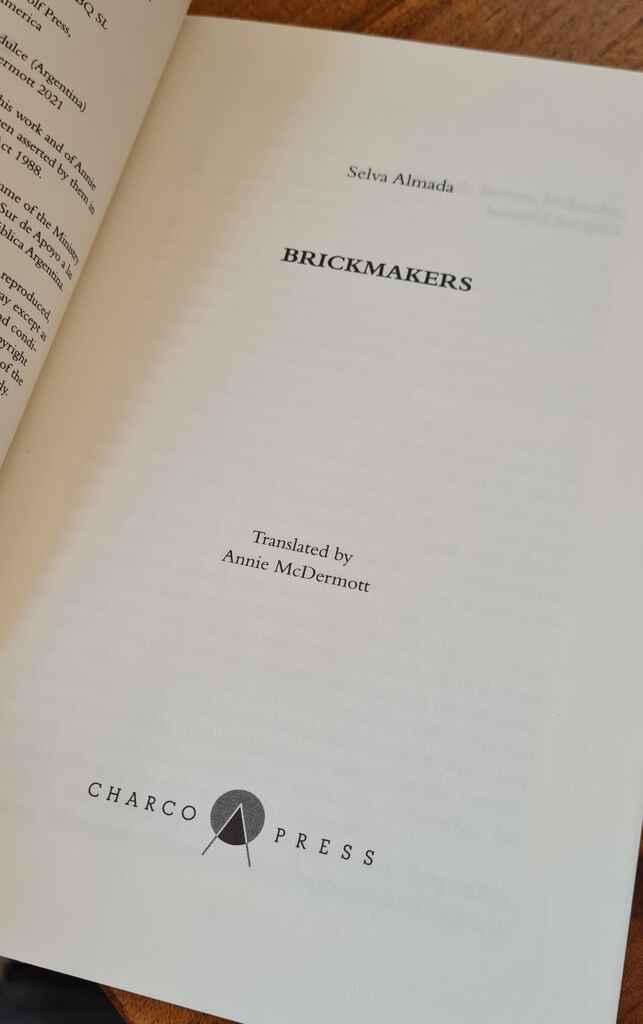
Title page of Selva Almada’s Brickmakers.
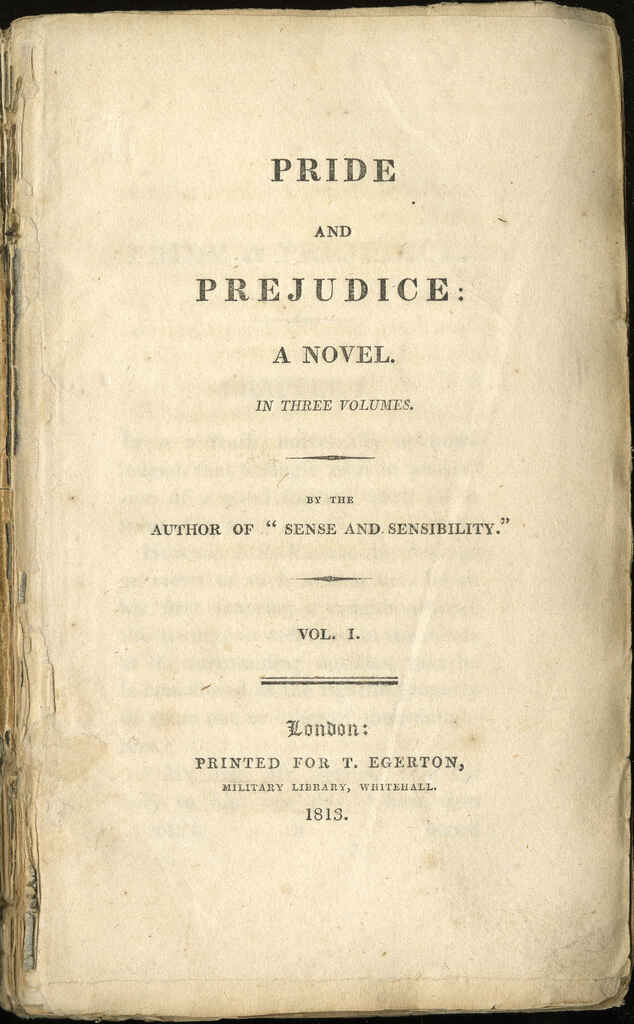
Title page of Jane Austen’s Pride & Prejudice.
Frontispiece
The frontispiece is a decorative illustration or photo on the page on the left hand side (also known as the verso) of the title page. It is not as common in contemporary books as in older books, but then again, most contemporary books have decorative covers instead.

Also by the author
If the author has published one or more books before the current title, the front matter might include a page outlining their oeuvre, whether standalones or part of a series. This page usually goes on the left hand side, and may replace the frontispiece, for example.
Dedication page
The dedication page is, like the name suggests, a page where the author names the person or people to whom they dedicate their book, and why. This typically comes after the copyright and title page on the right hand page, on a spread of its own.
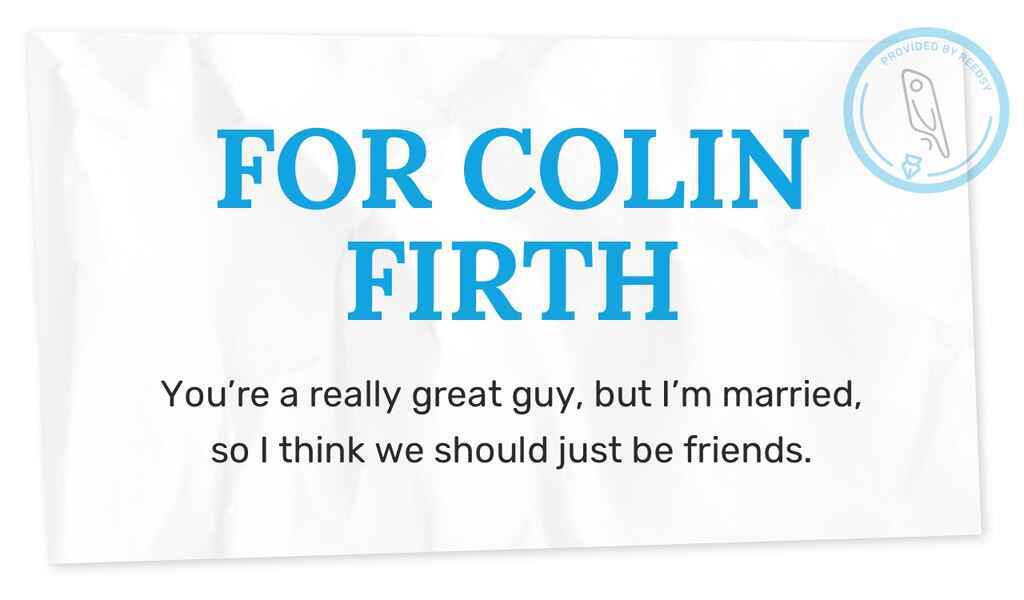
Austenland author Shannon Hale’s dedication to everyone’s favorite Mr. Darcy.
Table of contents
Some books, mainly anthologies, poetry books, nonfiction, and ebooks will also contain a table of contents to make navigation easier. This is a list of chapter headings and the page numbers where they begin. The table of contents (abbreviated ToC) should list all major sections that follow it, both body and back matter.
Epigraph
A quote or excerpt that indicates the book's subject matter, the epigraph can be taken from another book, a poem, a song, or almost any source. It usually comes immediately before the first chapter and is intended to hint at the theme or contents of the book.

Preface
An introductory passage written by the author, a preface relates how and why the book came into being, or provides context for the current edition.
Foreword
An introduction written by another person, usually a friend, family member, or scholar of the author's work to introduce the wider context of the piece or to set the reader up for what they’re about to read.
The body of a book
What most people think of when they think of a book — the main text — is referred to as the “body” of the book and goes between the front matter and back matter. For readers and writers alike, this is where the magic happens — it's not just the content that's crucial, but also how you arrange it, which is what we'll cover next.
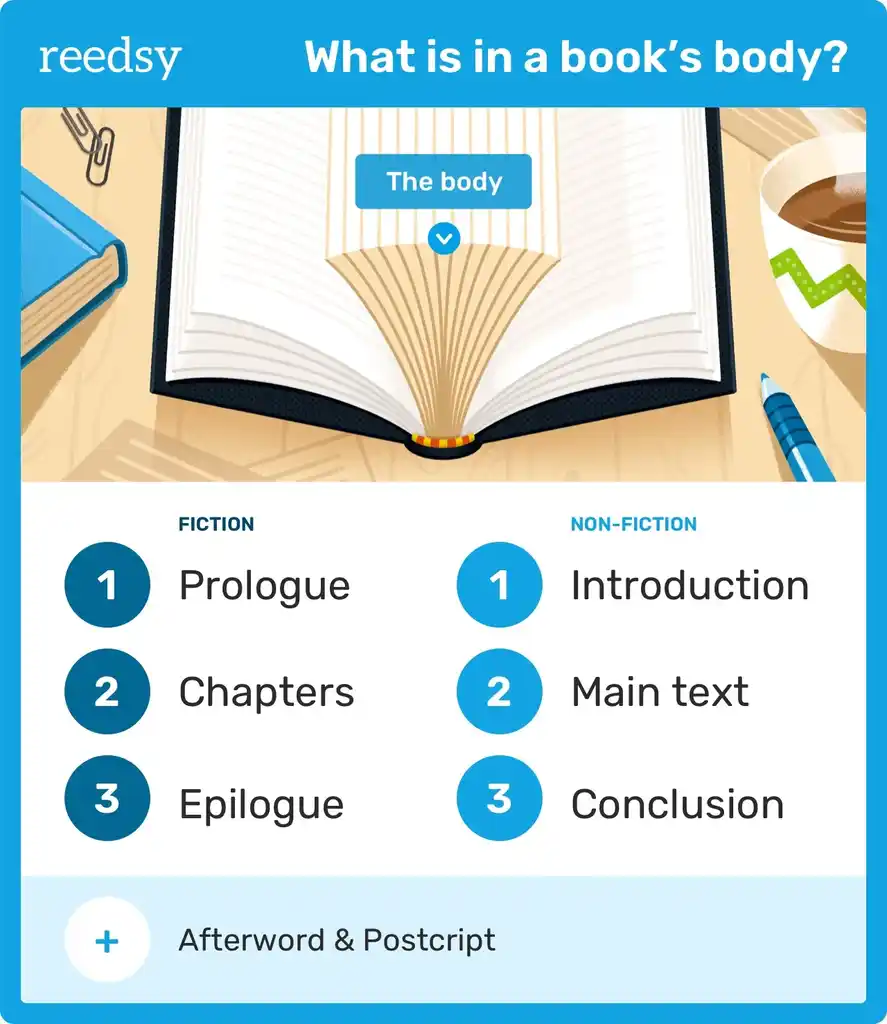
Prologue (for fiction)
The prologue is a section just before the novel begins that aims to set the stage and intrigue the reader about the story they’re about to read. Indeed, many prologues contain intriguing events that only become contextualized and make sense later in the story. For that reason, prologues are generally considered part of the body of the book, and not one of the paratextual elements included in the front matter.
Introduction (for nonfiction)
An introduction is a few pages that usher the reader into the subject matter. The intro goes over early events or information related to the main narrative, so the reader has a solid footing before they begin.
“What's the difference between a preface and an introduction? A preface is personal to the author, discussing why they wrote the book and what their process was. An introduction relates directly to the subject matter and really kicks things off — which is why it's part of the body, not the front matter.”
Chapters
Almost every single book has chapters, or at least sections, into which the narrative is divided. These chapters may not be designated by a chapter heading, or appear in a ToC; some authors start new chapters just by using page breaks or divide their text by a blank line. But if you don't use anything to break up your content, the text can seem impenetrable to the reader.
📏 To make your book more fluid and readable, learn more about how to master chapter length here.
Epilogue (for fiction)
A scene that wraps up the story in a satisfying manner, an epilogue often takes place some time in the future, relative to the events in the main chapters of the book. Alternatively, if there are more books to come in the series, the epilogue may raise new questions or hint at what will happen in the next installment.

Conclusion (for nonfiction)
A section that sums up the core ideas and concepts of the text. Explicitly labeled conclusions are becoming less common in nonfiction books, which commonly offer final thoughts in the last chapter instead, but more academic theses may still be formatted this way.
Afterword
Any other final notes on the book; can be written by the author or by someone they know.
Postscript
A brief final comment after the narrative comes to an end, usually just a sentence or two (e.g. “Matthew died at sea in 1807, but his memory lives on”).

Polish your book with expert help
Sign up to browse 3000+ experienced editors, designers, and marketers.
Learn how Reedsy can help you craft a beautiful book.
The back matter of a book
The back matter (also known as the “end matter”) is — you guessed it — material found at the back of a book, between the main body of text and the back cover. Authors use their back matter to offer readers further context or information about the story, such as endnotes or discussion questions, or even an excerpt from an upcoming book. But back matter can also be extremely simple: sometimes just a quick mention of the author's website or a note from the publisher.
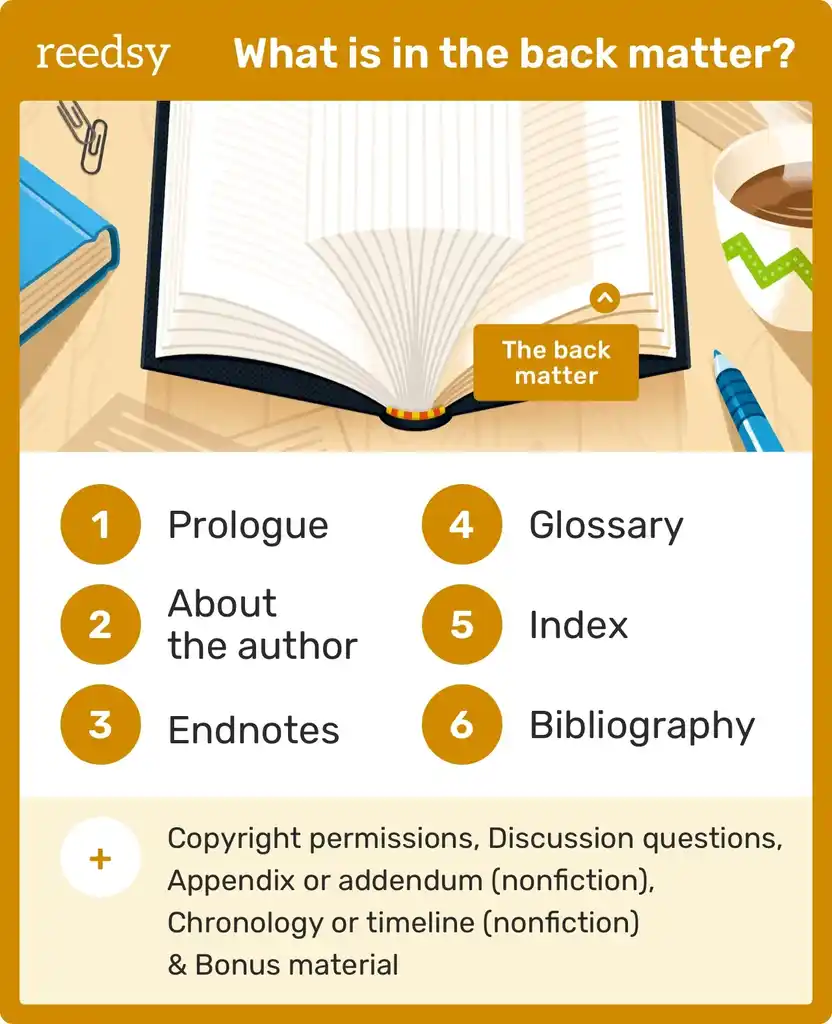
Acknowledgments
A section to acknowledge and thank all those who contributed to the book's creation. This may be the author's agent and editor(s), their close friends and family, mentors and other sources of inspiration. The acknowledgments typically appear right after the last chapter.
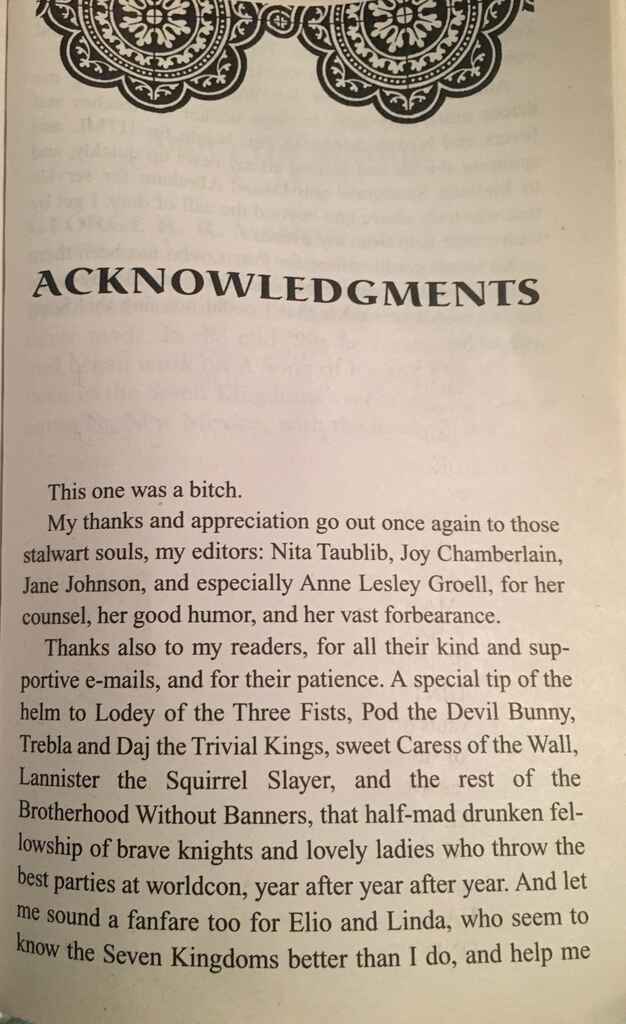
George R.R. Martin’s acknowledgements in A Feast For Crows. (Image: Reddit)
About the author
This is where the author gives a brief summary of their previous work, education, and personal life (e.g. “She lives in New York with her husband and two Great Danes”). Sometimes, this is part of the front matter instead, perhaps even printed directly onto the backside of the paperback cover. Or, if it’s a hardback with a dust jacket, this may go on the back flap.
For more on this topic, read through our guide to writing an author bio or check out some stellar About the Author examples here.
Copyright permissions
If the author has sought permission to reproduce song lyrics, artwork, or extended excerpts from other books, they should be attributed here (may also appear in the front matter in conjunction with the colophon page).
Discussion questions
Thought-provoking questions and prompts about the book, intended for use in an academic context or for book clubs.
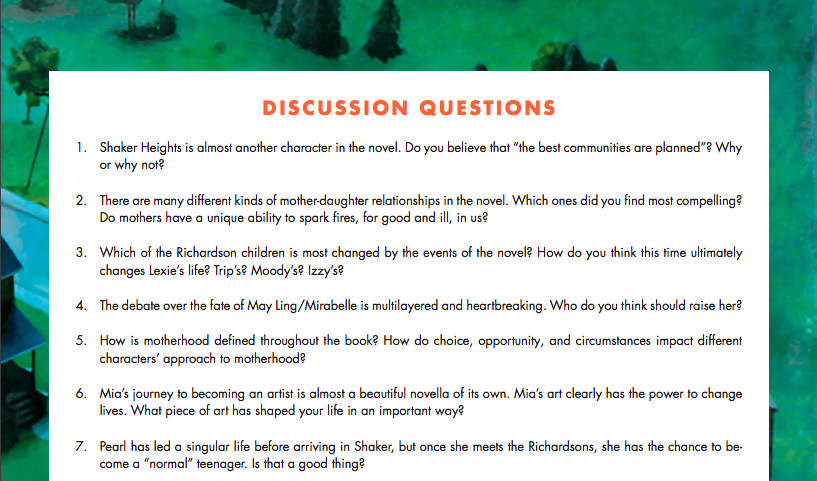
Appendix or addendum (nonfiction)
Additional details or updated information relevant to the book, especially if it's a newer edition.
Chronology or timeline (nonfiction)
List of events in sequential order, which may be helpful for the reader, especially if the narrative is presented out of order. A chronology is sometimes part of the appendix.
Endnotes
Supplementary notes that relate to specific passages of the text, and denoted within the body by superscripts. Almost always used in nonfiction, but occasionally found in experimental/comedic fiction as well, such as Infinite Jest by David Foster Wallace.
Glossary
Definitions of words or other elements that appear in the text. In works of fiction, the glossary may contain entries about individual characters or settings, made-up, or foreign words. The glossary usually appears in alphabetical order.
Index
A list of terms or phrases used in the book, along with the pages on which they appear, so the reader can find them easily. The index is also usually in alphabetical order.
Bibliography/reference list
A comprehensive breakdown of sources cited in the work. Your bibliography should follow a manual of style — luckily, it's easy to create one using free tools like Easybib. Note that this is a formal list of citations, not a bonus reading list on your subject; that would go in the afterword or appendix.
Bonus material
Some authors and publishers choose to include other bonus material in the back matter of the book. This can include interviews with the author or an excerpt of another book by the author, such as the first chapter of the sequel. This is especially common in paperbacks, as the author may have had time to write or even publish the second book.
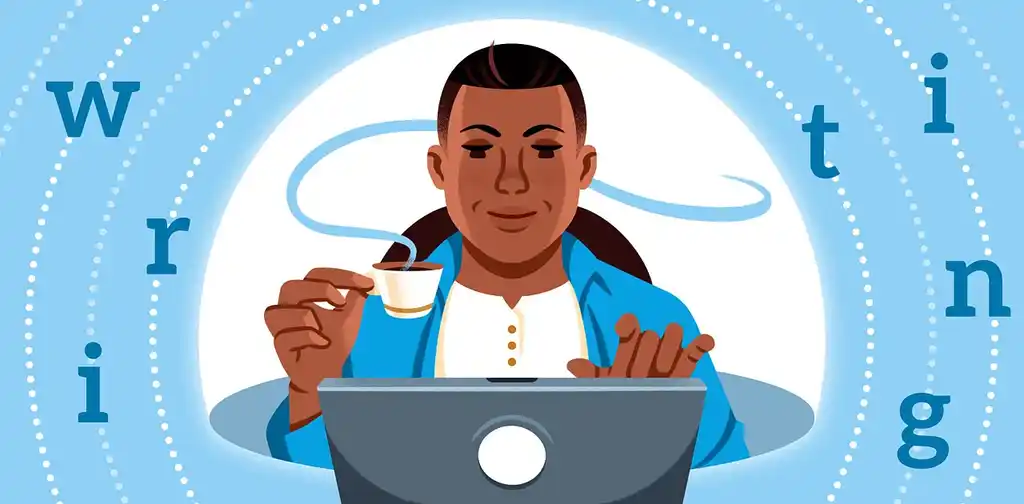
FREE FORMATTING APP
Reedsy Studio
Format your manuscript for print or EPUB with a single click.
If you're ready to go a little deeper, head to the next part of this guide and prepare to get up close and personal with copyright pages!


